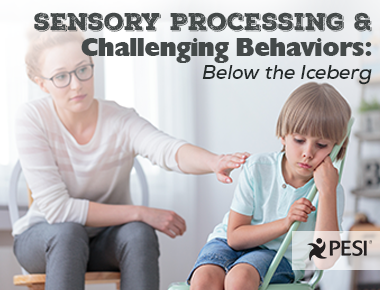Sensory Processing and Challenging Behaviors: Below the Iceberg

Grant, age four, was asked to leave two preschools because of misbehavior. With tousled brown hair, big brown eyes, and a playful spirit, he both charmed and confused most of the adults in his life. He had such difficulty following directions that his teachers had to reprimand him every few minutes. They described him as totally confusing, “adorable and sweet one minute, and breaking the rules the next.” Most challenging was that he typically laughed when he was disciplined. His behavior baffled everyone.
When the team looked below the surface of Grant’s apparent defiance, they learned that what caused his inappropriate laughter was likely embarrassment and confusion. A sensitive child who was prone to self-doubt, he laughed when he felt anxious. It was an automatic response to his failed attempts at good behavior.
Grant didn’t know or understand that certain things in the environment sent him into a stress response. His sensory over-reactivity (extreme sensitivity to certain sounds and types of touch) caused him to break rules regularly, giving the impression of misbehaving. Not grasping why he continued to get in trouble, Grant responded by laughing. This often left the adults in his life not only puzzled but also annoyed, making it difficult for them to engage warmly and connect with him.
When we look only above the surface, we tend to blame the child, the parent, or the caregiver. Looking below the surface opens new pathways for seeing the child’s behaviors as adaptations to internal needs, resulting in more compassion and less blame. When we properly understand children’s behaviors, we can better support their sensory motor and emotional development by attuning to what they need in the body and mind.
Looking at behaviors both above and below the surface provides a new way to tailor interactions and strengthen relationships. I call this approach to tailoring our interactions to meet each child’s emotional needs Personalized Attunement. Personalized attunement is a way of understanding what each individual needs, in order to promote responsiveness, warmth, and engagement. When we practice personalized attunement, we are better able to manage the inevitable dynamic shifts in a child’s receptivity, mood states, and availability for learning.
Within relationships, infants and toddlers need support from adults to manage their physical and emotional states until they can learn to calm themselves and develop self-regulation (Bialer & Miller, 2011). A calm alert state is essential for growth and development. Loving and warmly engaged relationships support calm attention, and when there is difficulty in either calm attention or engagement, we need to ask why. Are the reasons for the difficulties obvious and above-the-surface? Or are they less obvious, and below-the-surface, requiring a larger perspective and team collaboration with a qualified occupational therapist?
If you believe that a child you are working with has unusual responsivity to sensory information, it is essential to work with a therapist trained in sensory processing and integration. Most often, this is an occupational therapist, although other helping professionals such as physical therapists may also be trained in this sub specialty.
Although the causes of developmental delays are unlimited, in clinical practice, I have found that sensory-processing differences often contribute to children’s challenges in emotional regulation and socialization. Yet, surprisingly, many professionals are not trained to recognize the significance of sensory issues. When questions arise about a young child’s social or emotional development, it is beneficial to consider sensory-processing challenges because the integrity of the sensory-motor system has a hefty impact on emotional regulation.
Dr. Miller’s STAR Center (for Sensory Therapies and Research) uses a treatment model that places emotional regulation at the heart of treatment for children with sensory processing disorders. The treatment model is known as ART: Arousal modulation, Relationships and Engagement, and The Just Right Challenge. Therapists at the world-renowned center work to develop trusting relationships with the child and entire family to help support the child’s “arousal modulation,” the ability to feel calm in the body and mind. “The Just Right Challenge” refers to the effort to direct a child toward activities that sufficient for growth but not so challenging that they take the child away from a calm and alert state for too long.
The Star Institute’s website contains a treasure trove of information for parents and professionals alike. I highly recommend it as a first step if you suspect that a child you love or work with has sensory challenges impacting her ability to have joyful and warmly engaged relationships.
Let’s stop blaming children for their behaviors and compassionately look below the surface to discover how we can truly help them.
*Excerpted from: Delahooke, Mona (2017) Social and Emotional Development in Early Intervention.
Dr. Delahooke describes a roadmap to achieving this goal for pediatric professionals in her new book on social and emotional development.
She will be training on this topic in the greater Seattle area next month. Come join us for a one-day workshop on shifting the lens on behavioral treatments — November 7, 9 and 10, 2017. Here’s a code for half off the tuition: MDWA100.
Topic: Children and Adolescent Behavioral




